Simplify Off-Grid Photovoltaic Power Solutions with Integrated Chargers/Inverters
Contributed By DigiKey's North American Editors
2025-05-15
Off-grid power solutions supported by photovoltaic (PV) panels using maximum power point tracking (MPPT) are becoming popular as users adopt alternative energy sources. However, these systems are complex to install and configure. The combination of options demands multiple inverters and chargers, adding to costs.
Designers can now simplify and reduce the cost of off-grid power and battery charging by using a single integrated AC/DC charging, DC/AC inversion, and AC bypass unit.
This article briefly reviews off-grid power applications and the complexities of PV panel/MPPT charging. It then introduces integrated units from MEAN WELL to show how they can simplify installation and operation while reducing costs. A household application demonstrates the advantages of using an integrated product.
What is an off-grid power application?
Off-grid power is becoming popular because technology has matured to a point where these systems are reliable, efficient, and cost-effective, allowing users to gain independence from energy utilities.
As the name suggests, off-grid power is derived from non-utility energy sources, typically PV panels that convert sunlight to electricity. Wind power is also an option.
For complete grid autonomy, off-grid systems demand several key components:
- PV panels: to convert sunlight to DC electricity
- External solar MPPT charger: to optimize power flow to the batteries to maximize energy storage
- Batteries: to store the energy generated by the PV panels
- DC/AC inverter: to convert battery power into the AC required for household appliances
While many users strive for complete energy autonomy, they understand that PV panels might not consistently generate enough power for all their domestic systems and will take the sensible precaution of linking back to the utility provider. The AC input from the grid is converted to DC power to boost battery energy (Figure 1).
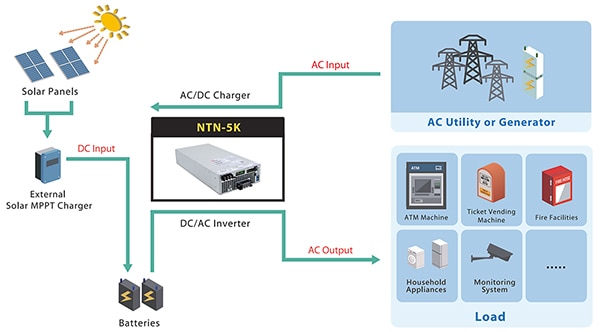 Figure 1: Shown is a PV panel-powered, off-grid power system with back-up AC utility input. (Image source: MEAN WELL)
Figure 1: Shown is a PV panel-powered, off-grid power system with back-up AC utility input. (Image source: MEAN WELL)
An autonomous off-grid system is practical, but not simple to implement. Set-up and maintenance demand attention, and adding a power return to charge the batteries increases complexity. Assuming the PV panels are mounted in the optimum position and at the best angle, and the batteries have sufficient capacity to store enough energy to power the dwelling through hours of limited or zero sunlight, then the external solar MPPT charger, AC/DC charging, DC/AC inversion, and AC bypass are the key elements determining the efficacy of the system.
One of the inverter’s jobs is to convert the DC electricity derived from a system comprising PV panels and batteries into a 230 V/60 Hz output. A product such as the MEAN WELL ISI-501-212B inverter accepts a 12 VDC input while offering a true sine wave output of 450 W with a total harmonic distortion (THD) of <3%, and an AC regulation of ±3%.
In the set-up shown in Figure 1, the inverter operates as an MPPT PV charger, including the constant current and constant voltage charging characteristics demanded by lead-acid batteries. The MEAN WELL unit provides a charge current up to 30 amperes (A) with an MPPT voltage range of 25 V to 50 V to replenish open or sealed lead-acid batteries.
What is MPPT?
MPPT is used with variable power sources such as PV panels to maximize energy extraction as conditions vary. MPPT addresses the challenges that arise from power transfer efficiency from the PV cell varying with solar flux, shading, PV panel temperature, and the load's electrical characteristics. As these conditions change, the load characteristic (impedance) that offers the highest power transfer also changes. The system is optimized when the load characteristic maintains power transfer at the highest efficiency, which is the maximum power point (MPP). MPPT is the process of adjusting the load characteristic as the conditions change to achieve the MPP.
Most modern MPPTs provide around 93 to 97% efficiency in the conversion. The MEAN WELL ISI-501-212B offers a typical conversion efficiency of 98%.
The output from the ISI-501-212B’s MPPT charger is used to charge the off-grid power system’s batteries utilizing the PV panels’ outputs. This is done using a defined constant current/constant voltage charging profile that uses MPPT to ensure the highest battery capacity and maximize the number of battery charging cycles (Figure 2). The float stage keeps the battery at a near-full charge level to prevent self-discharge.
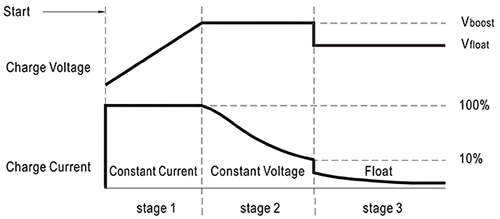 Figure 2: Shown is a constant current/constant voltage charging profile using MPPT to optimize battery capacity while maximizing the number of battery charging cycles. (Image source: MEAN WELL)
Figure 2: Shown is a constant current/constant voltage charging profile using MPPT to optimize battery capacity while maximizing the number of battery charging cycles. (Image source: MEAN WELL)
The importance of pure sine wave AC voltages
While the ISI-501-212B’s MPPT charger is key, it is only one part of an off-grid power system. For example, DC/AC inversion is needed to convert the power from the lead-acid or lithium-ion (Li-ion) batteries into the AC voltage demanded by household appliances. Such appliances must be supplied with pure sine wave AC voltages to avoid electrical challenges such as power factor correction.
The DC/AC inverter uses an H-bridge circuit and control circuitry such as pulse width modulation (PWM) to do this. Combining the H-bridge and PWM creates an average voltage approximating a sine wave. PWM is typically controlled by one or more microcontroller units (MCUs) and involves varying the width of the pulses to create an average voltage that forms the approximate sine wave. Further reduction in harmonic distortion can be achieved by inductor-capacitor (LC) filtering, which smooths out the waveform and produces a cleaner sine wave.
For example, MEAN WELL’s NTN-5K-148 continuous inverter uses MCUs to generate a true sine wave with a THD of <3% (Figure 3).
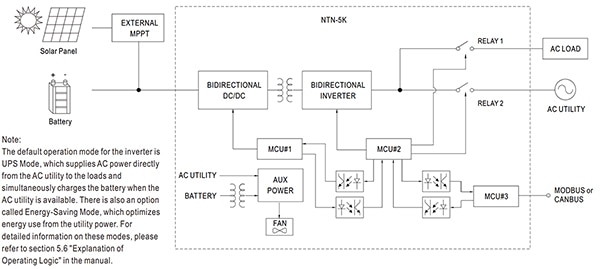 Figure 3: The NTN-5K-148 continuous inverter uses MCUs to generate a true sine wave AC output with a THD of <3%. (Image source: MEAN WELL)
Figure 3: The NTN-5K-148 continuous inverter uses MCUs to generate a true sine wave AC output with a THD of <3%. (Image source: MEAN WELL)
One size fits all
Using PV panels, a MEAN WELL ISI-501-212B inverter, and an NTN-5K-148 continuous inverter enables designers to build a complete off-grid system, but the continuous inverter offers even more. Within the one product, a developer can bring AC/DC charging for batteries, DC/AC inversion to power appliances, and an AC bypass unit.
The NTN-5K-148 requires a 48 V input and produces a 110 VAC output. It can supply a continuous 4,000 W with a peak efficiency of 93%. It is part of the MEAN WELL NTN-5K series, which has several variants. For example, the NTN-5K-2380 is a highly reliable off-grid true sine wave DC/AC power inverter with built-in AC charger and UPS function (AC by-pass). Its key features include a digital design with MCU control, streamlined control circuitry that quickly responds to environmental changes and improves reliability, a high-quality fan with low acoustic noise, continuous 5,000 W output, and 230 VAC output from a 380 VDC input. Peak efficiency is 94.5% (Figure 4).
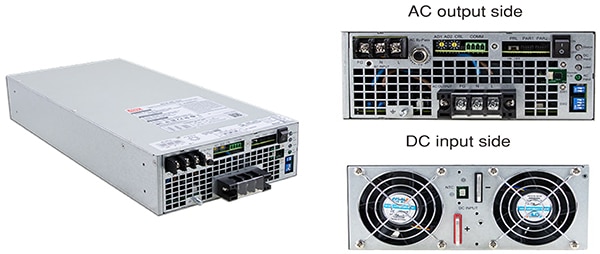 Figure 4: The NTN-5K-2380 is an off-grid true sine wave DC/AC power inverter with built-in AC charger and UPS function (AC bypass). It offers a continuous 5,000 W and 230 VAC output from a 380 VDC input. (Image source: MEAN WELL)
Figure 4: The NTN-5K-2380 is an off-grid true sine wave DC/AC power inverter with built-in AC charger and UPS function (AC bypass). It offers a continuous 5,000 W and 230 VAC output from a 380 VDC input. (Image source: MEAN WELL)
The NTN-5K series is suitable for use in residential, commercial, marine, automobile, mine, construction site, and remote areas without access to utility power (Figure 5). The series features a built-in active current sharing function and can be connected with up to 6 units in parallel to provide higher AC output power.
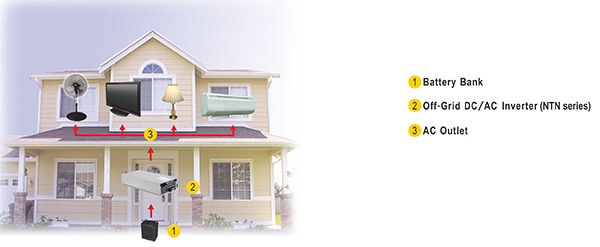 Figure 5: Shown is a typical domestic application of an NTN-5K. (Image source: MEAN WELL)
Figure 5: Shown is a typical domestic application of an NTN-5K. (Image source: MEAN WELL)
Conclusion
Off-grid power systems are appealing because of the independence they offer. However, such systems are complex to install and configure. MEAN WELL’s continuous inverter has simplified and reduced the cost of off-grid power and battery charging by employing an integrated AC/DC charging, DC/AC inversion, and AC bypass unit. An example is the NTN-5K series of chargers/inverters that handle the functions required for off-grid household power and battery charging.

Disclaimer: The opinions, beliefs, and viewpoints expressed by the various authors and/or forum participants on this website do not necessarily reflect the opinions, beliefs, and viewpoints of DigiKey or official policies of DigiKey.







